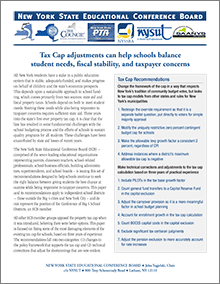Seven leading New York state education groups seek clarification of what school districts should rely upon as baseline state aid figures as they proceed with developing their budgets.
The New York State Educational Conference Board (ECB) has outlined a series of recommendations that would fix some of the most damaging elements of the state-s Property Tax Cap for schools.

COMPLETE REPORT: PDF
The ECB paper explains that schools have always sought a balance between a budget that meets the needs of students and addresses the concerns of taxpayers, but the tax cap signed into law in 2011 has created some fundamental challenges with the school budgeting process.
The 11 recommendations in the paper fall into two categories: (1) changes to the policy framework that supports the tax cap and (2) technical corrections that adjust for shortcomings that are now evident based on three years of practical experience with the cap.
The framework of New York's tax cap is uniquely restrictive for school districts. The ECB recommendations call for redesigning of the voter approval mechanism for districts seeking to override the cap, which currently requires a 60 percent supermajority. ECB also calls for the harmful zero percent contingency budget cap to be to be adjusted. Neither of these tax cap provisions, the 60 percent voter supermajority or the zero percent contingent cap, applies to the state-s towns, cities, villages, and counties.
The paper also cites tax caps models that are at work in Massachusetts and New Jersey that do not contain the restrictive elements of New York-s cap for schools.
A second group of recommendations in the paper would address technical problems with the tax cap calculation itself. They relate to items such as improving how the formula accounts for payments-in-lieu of taxes (PILOTs), BOCES capital costs, transfers to a Capital Reserve Fund, and the carryover provision.
The paper points out that the challenges introduced by the cap have only been exacerbated by the state aid losses of recent years.
The Educational Conference Board is comprised of the state's seven leading educational organizations representing parents, classroom teachers, school-related professionals, school business officials, building administrators, superintendents and school boards. Its members are: the Conference of Big 5 School Districts; NYS Association of School Business Officials; NYS Council of School Superintendents; New York State PTA; NYS School Boards Association; New York State United Teachers and the School Administrators Association of NYS.
Tax Cap Recommendations
Change the framework of the cap in a way that respects New York's tradition of community budget votes, but looks to tax cap models from other states and rules for New York's municipalities
- Redesign the override requirement so that it is a separate ballot question, put directly to voters for simple majority approval
- Modify the uniquely restrictive zero percent contingent budget cap for schools
- Make the allowable levy growth factor a consistent 2 percent, regardless of CPI
- Address instances where a district's maximum allowable tax cap is negative
Make technical corrections and adjustments to the tax cap calculation based on three years of practical experience
- Include PILOTs in the tax base growth factor
- Count general fund transfers to a Capital Reserve Fund in the capital exclusion
- Adjust the carryover provision so it is a more meaningful factor in school budget planning
- Account for enrollment growth in the tax cap calculation
- Count BOCES capital costs in the capital exclusion
- Exclude significant tax certiorari judgments
- Adjust the pension exclusion to more accurately account for rate increases